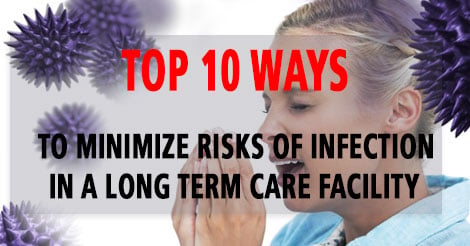With summer winding down, and flu season is lurking, it is always a good idea to remind ourselves of proper practices to minimize the risk of spreading infection through our facilities.
Here are 10 ways to do so:
10 - CONTROL IT AT THE SOURCE (Also known as Source Control)
This means that there should be guidelines issued at the point of entry of your facility (ex. Hand hygiene, coughing into one’s sleeve, wearing a mask when there is risk of contagion). Please note that for hand hygiene, there are waterless products available that contain alcohol in concentration of less than 60%. As there is no proof of their efficacy, these should not be considered in a healthcare setting.
9 - EFFECTIVE SCREENING
In critical periods of the year, it is important to assess the resident population of your facility in a timely manner. Signs to look for: Coughs, fever, sore throat, pain in the joints or muscles
8 - LAB TESTINGS
Ensure that you have provisions for testing to confirm by analysis the type of infection that may be present in your facility. It allows for quick notifications to your assigned physicians as well as to infection prevention professionals. A quicker, more accurate reaction will help you address infections at the early stages.
7 - IMMUNIZATION
A vaccination is recommended especially to protect against seasonal influenza. It is still one of the most effective ways to protect your residents, the visitors, your personnel, as well as yourself.
6 - APPROPRIATE ROOMING
Ideally infectious residents should be isolated. If your facility does not allow that, they should be rooming with other infected individuals (cohorting). If that is not possible and rooms are shared, privacy curtains should be drawn between beds. There should be signage at the entrance of designated rooms.
5 - PERSONAL PROTECTIVE EQUIPMENT (PPE)
In addition to other policies, facial protection* should be worn by healthcare personnel within 2 meters of resident(s) with possible or diagnosed infection. In Long Term Care, it is highly recommended to wear gloves* when tending to residents or when in contact with frequently touched areas. A long sleeved gown* should also be considered. A great tool to keep all your PPE supplies in one place is the PPE Caddy, which can be wall or door mounted and encourages compliance.
*Please note that all items should be discarded just before leaving the resident’s room.
4 - EQUIPMENT
All equipment used in the care of residents should be cleaned and disinfected before reuse with another resident. If you are using single use items, they should be discarded in a clearly identified waste bin. During infection periods, personal effects should not be shared between patients.
3 - THOROUGH AND REGULAR CLEANING OF THE ENVIRONMENT
Most healthcare cleaning and disinfecting products are appropriate for cleaning in most infection crisis. All horizontal surfaces (floors, tables, counters, etc.) and frequently touched surfaces should be cleaned at least twice a day. Protocols should also be put in place when a resident’s room is made available.
2 - LAUNDRY PRACTICES
Your laundry always applies the strictest washing protocols. Standard washing formulas, water temperatures, etc. have been thought to address all types of situation and rarely need to be adjusted.
1 - OUTBREAK MANAGEMENT POLICY
All nursing homes should have a written plan for managing all types of outbreaks. If protocols are understood, followed and properly communicated, it will ensure the safety of your personnel and patients.
Infection control is critical to the safefy and well-being of the care recipient, as well as the caregiver, and it is best to be proactive. For all your linen supply needs and questions, let MIP Inc. take care of you!
Written by Gabriel Boardman, from MIP Inc.





.png)


